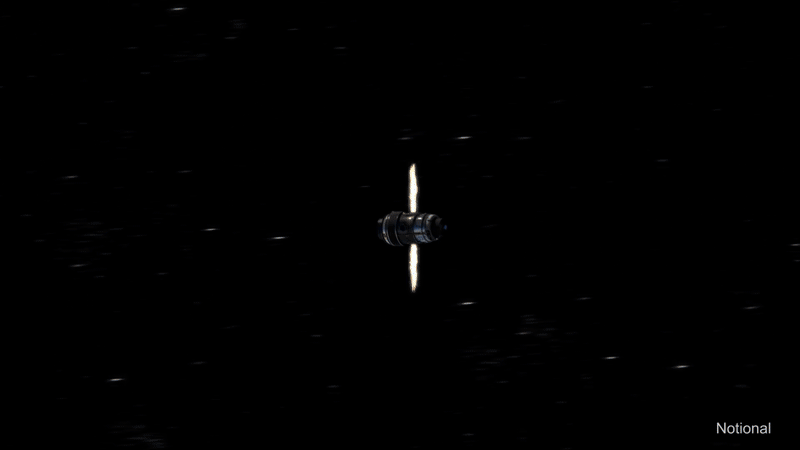These Interceptors will form the Basis of Golden Dome for America
Brilliant Swarms from Booz Allen is the latest iteration in the Evolution of Space-Based Interceptors
Brilliant Swarms is a proposed space-based interceptor constellation designed to enhance U.S. missile defense by autonomously tracking and neutralizing ballistic threats in space.
Table of Contents
Introduction and Overview
Historical Development
Implications
Specifications
Concept of Operations
Systems Engineering
Systems Engineering Requirements
Conclusion
References
1. Introduction and Overview
Brilliant Swarms is Booz Allen’s advanced space-based interceptor (SBI) solution, developed in response to the escalating threat of ballistic missile attacks from near-peer adversaries such as China and Russia, as well as rogue states like North Korea and Iran. The concept of space-based interceptors dates back to the Strategic Defense Initiative (SDI) era of the 1980s, when the U.S. explored orbital missile defense platforms to counter emerging threats. Early SBI programs were limited by high costs, technological immaturity, and concerns over weaponizing space. As missile technology evolved, adversaries introduced sophisticated countermeasures and delivery systems that challenged ground- and sea-based interceptors, exposing gaps in the existing missile defense system (MDS). Recent advances in artificial intelligence, digital engineering, and small satellite manufacturing have revitalized the feasibility of space-based solutions, enabling the deployment of affordable, autonomous constellations.
Brilliant Swarms leverages a network of small, AI-enabled satellites to autonomously track, target, and intercept ballistic missiles during their most vulnerable flight phases: boost, ascent, and mid-course. By operating as an outermost layer of defense, the system addresses critical shortcomings in legacy architectures, increasing the probability of successful intercepts before adversaries can deploy countermeasures. This capability not only enhances the resilience and flexibility of U.S. missile defense but also positions the nation at the forefront of space-based defense innovation. Thesis: Brilliant Swarms is essential for modernizing U.S. missile defense, offering rapid, scalable, and cost-effective protection against evolving global missile threats.
2. Historical Development
The U.S. missile defense architecture was originally designed to counter limited threats from rogue states, relying primarily on ground- and sea-based interceptors. In the early 1980s, President Ronald Reagan introduced the Strategic Defense Initiative (SDI), commonly known as “Star Wars,” which aimed to create a comprehensive missile shield using space-based systems. One notable concept from this era was “Brilliant Pebbles,” which envisioned a constellation of small, autonomous interceptors deployed in orbit to detect and destroy incoming ballistic missiles. Despite its innovative approach, Brilliant Pebbles and other SDI-era projects faced significant obstacles, including high costs, technical immaturity, and concerns about the weaponization of space.
As adversaries advanced their missile delivery systems and countermeasures, the limitations of traditional missile defense became more evident, reinforcing the need for a viable space-based solution. Previous SBI concepts were constrained by the technological and budgetary realities of their time. However, recent progress in artificial intelligence, digital engineering, and satellite manufacturing has transformed these possibilities, enabling the development of affordable, rapidly deployable constellations like Brilliant Swarms and marking a significant milestone in the evolution of missile defense. Building on lessons from the SDI era and available technology of today, concepts like Brilliant Swarms are now moving toward practical implementation for space-based interceptors.
3. Implications
Strategic Implications:
Deterrence: Brilliant Swarms if successfully proven out will strengthen the U.S. deterrence by demonstrating the ability to intercept ballistic missiles at multiple points in their flight path, complicating adversary planning and reducing the perceived benefits of a missile attack. The system’s autonomous, persistent presence in space signals a credible and timely response capability, making it harder for potential adversaries to exploit gaps in existing defenses. This visible commitment to missile defense can dissuade adversaries from considering missile aggression as a viable option. By raising the cost and uncertainty of a successful attack, Brilliant Swarms can contribute to maintaining strategic stability.
Resilience: The addition of a space-based interceptor layer increases the overall survivability of the missile defense system (MDS) by diversifying its architecture beyond ground- and sea-based assets. Brilliant Swarms’ distributed constellation can adapt to losses or attacks on individual satellites, minimizing the risk of a single point of failure. It architecture can provide modularity and rapid reconfiguration capability, potentially enabling the system to respond dynamically to evolving threats or attempts at countermeasures. This flexibility ensures that U.S. missile defense remains robust even in contested or degraded operational environments.
Global Stability: By introducing a credible and persistent space-based interception capability, Brilliant Swarms may alter adversary calculations regarding the use of ballistic missiles. The presence of such a defense system could reduce the likelihood of missile attacks by increasing the perceived risk of failure for aggressors. Additionally, the system’s transparency and integration with allied defense networks may foster greater confidence among U.S. partners, contributing to collective security. Over time, these factors can help stabilize the broader security environment and discourage arms races or escalation driven by missile threats.
Operational Implications:
Coverage: Brilliant Swarms would provide continuous, global surveillance by deploying a constellation of autonomous satellites, ensuring no region is left unmonitored. The system’s architecture allows for rapid reconfiguration, enabling it to adapt to shifting threat environments or emerging missile launches in real time. This persistent coverage enhances early warning capabilities and supports coordinated defensive responses across multiple theaters.
Cost Efficiency: The proper use of digital design tools will streamline the development process and reduce both time and resource requirements compared to traditional approaches. Modularity in satellite construction enables component to be standardization and mass-production, lowering per-unit costs and simplifying future upgrades. These efficiencies make it feasible to deploy and maintain large-scale constellations, expanding defensive reach and potentially reducing overall expenditure.
Societal Implications:
Public Safety: Brilliant Swarms could enhance national and allied security by providing an additional layer of defense against ballistic missile threats, reducing the risk of successful attacks. A persistent surveillance and rapid response capability would safeguard civilian populations and critical infrastructure, contributing to broader societal stability.
Technological Leadership: The deployment of Brilliant Swarms would demonstrate the U.S.’s capability in integrating advanced AI, digital engineering, and satellite technology in defense applications. This innovation would strengthens the overall impresison of U.S military capability while driving progress in related fields, promoting technological growth and competitiveness in the aerospace sector.
Economic Impact: The development and deployment of Brilliant Swarms could stimulate economic activity in fields such as high-tech manufacturing, engineering, and research jobs. Investments in advanced satellite systems and supporting infrastructure can have positive spillover effects, fostering growth in commercial space and defense industries.
International Collaboration: By integrating with allied defense networks and sharing technology, Brilliant Swarms can enhance collective security and strengthen strategic partnerships. Collaborative efforts in space-based missile defense may promote standardization, interoperability, and shared situational awareness among partner nations.
4. Specifications

Architecture:
Brilliant Swarms will consist of a distributed constellation of small, autonomous satellites equipped with advanced sensors, propulsion, and interception technologies. Each satellite will be designed for exo-atmospheric engagement, meaning it would neutralize ballistic threats in space before they re-enter the atmosphere. The satellites operate collaboratively, sharing data and coordinating responses to maximize coverage and interception success. Given a robust, radiation-hardened construction, the satellites would function reliably in the harsh environment of low Earth orbit, while secure communication links would ensure integration with ground-based missile defense systems.
Key Capabilities:
AI-enhanced battle management and command/control: The system would use artificial intelligence to process sensor data, prioritize threats, and coordinate interception strategies across the constellation. This capability would enable rapid decision-making and efficient allocation of resources during high-stress engagements.
Autonomous tracking, targeting, and interception: Each satellite would independently detect, track, and engage incoming missiles, reducing reliance on ground control and minimizing delays. This autonomy would be critical when responding to threats that emerge quickly or in contested environments.
Human-on-the-loop oversight: While the satellites operate autonomously, human operators would be required to maintain oversight and potentially intervene in critical situations, ensuring accountability while allowing for real-time adjustments against evolving threat assessments.
Rapid constellation reconfiguration: The system could reposition satellites dynamically in response to new threats or compensate for losses, maintaining optimal coverage and effectiveness. This agility supports persistent defense in unpredictable scenarios.
Digital twin-enabled rapid prototyping and testing: Each satellite design would be validated through digital twins—virtual models that simulate performance under various conditions. Digital twins have been shown to accelerate development cycles and improves reliability before deployment.
Networked situational awareness: Satellites would share real-time data with each other and ground stations, creating a unified operational picture and enabling coordinated multi-satellite engagements against complex threats.
Resilient communications and cybersecurity: The constellation would utilize secure, redundant communication channels and advanced cyber protections to resist jamming and electronic warfare, ensuring the integrity of battle management functions.
On-orbit maintenance and upgrade capability: The interceptor satellites would be designed for remote diagnostics, software updates, and modular hardware replacement, allowing ongoing improvements and adaptation to evolving threats without the need for physical retrieval.
Phases of Intercept:
The system would be designedto engage ballistic missiles during three critical flight phases: boost, ascent, and mid-course. In boost phase, the missile is accelerating and most vulnerable due to its heat signature and lack of countermeasures. During ascent, the missile transitions from atmospheric flight to space, presenting a clear target for exo-atmospheric interceptors. The mid-course phase occurs in space, where the missile may deploy decoys or countermeasures, but the constellation’s persistent coverage and advanced sensors enhance detection and discrimination capabilities. By targeting threats in these phases, Brilliant Swarms increases the probability of successful interception before the missile can reach its intended target.
Modularity:
The satellites would be built with modular components, allowing for scalable deployment based on threat levels and budget constraints. Modules would be capable of being swapped or upgraded to introduce new sensors, propulsion systems, or interception payloads as technology evolves. This approach would simplify manufacturing, maintenance, and integration with future systems, ensuring long-term adaptability and cost control.
Cost:
Brilliant Swarms would aim to achieve lower costs through several innovations.
The use of small satellites to utilize mass production and economies of scale, reducing unit costs compared to legacy space-based interceptors.
Advances in digital design and rapid prototyping to shorten development cycles and minimize expensive physical testing.
Modular architecture to further streamlines manufacturing and upgrades, while commercial launch services and standardized components contribute to more affordable deployment and operations.
Collectively, these factors could make large-scale, persistent space-based missile defense financially feasible for the first time.
5. Concept of Operations
This Concept of Operations (CONOPS) for Brilliant Swarms outlines how the system’s distributed satellite architecture and advanced technologies are integrated into a broader missile defense network. It describes the roles of key stakeholders, deployment strategies, and operational protocols that enable persistent, autonomous, and adaptive protection against ballistic threats. This section provides context for how Brilliant Swarms would function in real-world scenarios and could collaborates across defense and industry partners. This CONOPS therefore is only conceptual, and thus high-level and not complete.
Stakeholders:
U.S. Department of Defense (DOD): The DOD would oversee strategic direction, funding, and integration of Brilliant Swarms into national security frameworks, ensuring alignment with overarching defense objectives.
Missile Defense Agency (MDA): The MDA would be responsible for technical oversight, program management, and operational coordination, facilitating the system’s deployment and interoperability with existing missile defense assets.
Allied defense partners: Defense partners would collaborate on information sharing, joint exercises, and operational integration, extending the reach and effectiveness of Brilliant Swarms across allied territories.
Commercial satellite and launch providers: Satellite and launch providers would supply launch services and satellite manufacturing expertise, supporting rapid deployment, scalability, and ongoing maintenance of the constellation.
Purpose:
This approach shifts missile defense from reactive, ground-based systems to a proactive, space-based layer that can engage threats earlier in their trajectory. By intercepting missiles before they can deploy decoys or maneuver, Brilliant Swarms reduces the complexity and risk associated with later-stage engagements, ultimately enhancing the overall effectiveness and reliability of national and allied missile defense architectures.
Operational Overview:
Pre-Deployment: The process begins with digital design and rapid prototyping, allowing engineers to simulate and refine satellite capabilities before physical production. Detailed constellation planning ensures optimal satellite placement and coverage, tailored to anticipated threat environments and evolving mission requirements.
Deployment: Satellites are launched and inserted into their designated orbits using commercial or government launch providers, with careful coordination to achieve the intended constellation geometry. Once in orbit, the satellites are integrated into the broader network, establishing secure communication links and synchronizing with ground-based and allied defense systems.
Operations: The constellation conducts continuous surveillance and threat detection, leveraging advanced sensors to monitor global activity around the clock. AI-driven algorithms identify potential threats and select optimal interception strategies, while autonomous systems carry out engagements with human oversight to ensure accountability and adaptability in complex scenarios.
Real-time battle damage assessment and constellation reconfiguration: After each engagement, the system rapidly assesses the outcome using onboard sensors and shared data, enabling immediate feedback for mission planning. The constellation can dynamically reconfigure, repositioning satellites as needed to maintain coverage and respond to new or shifting threats.
Post-Engagement: Following an intercept, data analysis is conducted to evaluate performance and inform future operations. System updates and remote maintenance are performed as needed, using software patches and modular hardware replacements to keep the constellation at peak readiness.
Key Capabilities:
Persistent global coverage: The constellation of satellites is positioned to provide uninterrupted surveillance and interception capabilities across the globe, ensuring that no region is left unprotected from ballistic threats. This persistent presence enables early detection and engagement of missiles regardless of their launch location or trajectory.
Rapid response to emerging threats: Brilliant Swarms can quickly identify and react to new or unexpected missile launches, leveraging autonomous decision-making and agile satellite repositioning. This rapid response capability minimizes the window of vulnerability and enhances the overall resilience of missile defense operations.
Modular, open systems for future upgrades: The modular architecture allows for straightforward integration of new technologies, such as improved sensors or advanced interceptors, as they become available. Open system standards ensure compatibility with current and future missile defense assets, supporting long-term adaptability and cost-effective modernization.
6. Systems Engineering

System Objectives:
Provide persistent, autonomous missile defense coverage. The system must operate continuously and independently, ensuring uninterrupted protection against ballistic threats worldwide.
Enable rapid, scalable deployment and reconfiguration. The architecture should support flexible scaling and dynamic adjustments to respond to evolving threat environments and mission needs.
Integrate seamlessly with existing Missile Defense System (MDS) components. Compatibility with current missile defense systems ensures a unified, layered defense approach and optimizes resource allocation.
Maintain high operational readiness and reliability. The system should be designed for minimal downtime and quick recovery from anomalies, supporting sustained mission effectiveness.
Support future technology insertion and upgrades. The design should accommodate new capabilities as technologies advance, ensuring long-term relevance and value.
Key Operational Capabilities:
AI-driven battle management. Advanced artificial intelligence will coordinate threat assessment, resource allocation, and engagement strategies across the satellite constellation.
Autonomous interception. Satellites must be able to detect, track, and neutralize threats independently, reducing response time and human workload.
Digital twin-enabled rapid prototyping. Virtual models can simulate satellite performance and mission scenarios, enabling faster, more reliable development and deployment cycles.
Secure, resilient communications. Robust, encrypted links will ensure uninterrupted data exchange between satellites and ground stations, even in contested environments.
Real-time situational awareness and reporting. The system will provide operators with comprehensive, up-to-date information on threats, system status, and mission outcomes.
Mission Requirements:
Detect, track, and intercept ballistic missiles in boost, ascent, and mid-course phases. The system must provide layered engagement opportunities to maximize interception probability.
Operate in contested space environments. Satellites should maintain functionality despite electronic warfare, jamming, or adversary interference.
Discriminate between actual warheads and decoys. Advanced sensors and algorithms must accurately identify genuine threats among complex countermeasures.
Maintain continuous coverage over designated threat corridors. The constellation should be configured to ensure no gaps in surveillance or interception capability.
Respond to multiple, simultaneous threats. The system must be capable of handling saturation attacks or coordinated launches from different locations.
Performance Goals:
Maximize probability of intercept: The system should be optimized to achieve the highest possible success rate against incoming threats.
Minimize response time from detection to engagement: Rapid decision-making and autonomous action are critical for intercepting missiles in their most vulnerable phases.
Achieve high reliability and mission availability: The system should meet stringent uptime requirements and quickly recover from failures.
Maintain low false alarm rates: Advanced discrimination algorithms should reduce unnecessary engagements and conserve interceptor resources.
Support rapid post-engagement analysis and learning. The system should collect and process engagement data to continuously improve performance.
Operating Conditions:
Space environment: radiation, temperature extremes, debris. Satellites must be hardened to withstand harsh orbital conditions and potential collisions.
Networked operations with ground and space assets: Seamless integration with other defense platforms is essential for coordinated missile defense.
Operate through periods of solar activity or space weather events: The system should remain functional during adverse environmental conditions.
Maintain operations during adversary counter-space activities: The architecture must be resilient to threats such as anti-satellite weapons or cyberattacks.
Support global, 24/7 coverage: The constellation should be positioned and managed to provide uninterrupted surveillance and defense capabilities.
Expected Opposition/Challenges:
Adversary countermeasures (decoys, jamming): The system must be equipped to detect, identify, and counteract sophisticated adversary tactics.
Space debris and anti-satellite threats: Satellites need collision avoidance capabilities and strategies to mitigate the risk of targeted attacks.
Evolving missile technologies: The system must adapt to new offensive capabilities, including hypersonic or maneuverable reentry vehicles.
Political and legal constraints on space operations: Compliance with international treaties and norms is necessary to maintain legitimacy and support.
Budgetary and logistical constraints: The program should balance performance goals with cost-effectiveness and manageable operational demands.
Design Considerations:
Modularity, scalability, interoperability, cost-effectiveness: The system should be flexible, upgradeable, and economically sustainable over its lifecycle.
Cybersecurity and data integrity: Robust protections are required to prevent unauthorized access and ensure the reliability of mission-critical information.
Efficient power management: Satellites should be designed for optimal energy use, supporting long-duration missions with minimal resupply.
Environmental impact and debris mitigation: The design should minimize the creation of additional space debris and support responsible end-of-life disposal.
Human factors and operator usability: Interfaces and controls should be intuitive, reducing training time and operator error.
Verification and Validation:
Digital simulation, hardware-in-the-loop testing, live-fire exercises: Comprehensive testing ensures that the system performs as intended in realistic scenarios.
The system shall meet defined acceptance criteria for operational deployment: Clear metrics and benchmarks will guide the transition from development to fielded capability.
The system shall achieve certification for integration with national defense networks: Formal approvals are required to ensure secure and reliable operation within existing infrastructure.
Conduct regular operational and maintenance drills: Ongoing exercises verify readiness and identify areas for improvement.
Implement continuous feedback and improvement cycles: Lessons learned from testing and real-world operations should inform upgrades and refinements.
7. Systems Engineering Requirements
Functional Requirements:
The system shall autonomously detect and track ballistic missile launches. Automated detection reduces response time and increases engagement opportunities.
The system shall provide real-time target identification and shot selection. Rapid, accurate assessments are essential for effective interception.
The system shall enable human-on-the-loop oversight for all engagements. Operators retain the ability to intervene or override automated actions as needed.
The system shall support rapid constellation reconfiguration. Flexibility in satellite positioning ensures continued effectiveness in dynamic threat environments.
The system shall maintain comprehensive logs and audit trails of all engagements. Detailed records support accountability, analysis, and system improvement.
Physical Requirements:
The system shall conform to size and weight constraints for small satellite launch vehicles. Compact design enables cost-effective, frequent launches.
The system shall utilize radiation-hardened materials suitable for space operations. Durability is essential for long-term functionality in orbit.
The system shall incorporate modular hardware components. This allows for straightforward repairs, upgrades, and replacement of subsystems.
The system shall be designed for minimal on-orbit servicing. Reliability and autonomy reduce the need for costly maintenance missions.
The system shall include built-in collision avoidance and maneuvering capabilities. Proactive measures help prevent damage from space debris or other satellites.
Environmental Requirements:
The system shall operate within the temperature and radiation ranges encountered in low Earth orbit. Environmental resilience is necessary for continuous operation.
The system shall maintain electromagnetic compatibility with existing space assets. Avoiding interference ensures cooperative operation with allied satellites.
The system shall withstand micro-meteoroid impacts and space weather events. Robust shielding and redundant systems enhance survivability.
The system shall minimize its own electromagnetic emissions to avoid detection or interference. Stealth and discretion can be critical in contested environments.
The system shall comply with international standards for space sustainability. Responsible design supports long-term access to orbital domains.
Maintenance Requirements:
The system shall support remote diagnostics and software updates. Continuous monitoring and improvements are possible without physical intervention.
The system shall require minimal on-orbit maintenance. High reliability and self-sufficiency reduce operational costs and downtime.
The system shall enable modular component replacement by robotic servicers or future crewed missions. This supports long-term sustainability and adaptability.
The system shall include predictive maintenance algorithms to anticipate failures. Early detection of issues minimizes disruptions.
The system shall maintain a secure, redundant backup of critical data and software. Disaster recovery protocols protect mission integrity.
Interface Requirements:
The system shall provide secure data exchange with ground and space-based MDS components. Encrypted communications safeguard sensitive information.
The system shall support standardized command and control protocols. Compatibility with allied systems streamlines joint operations.
The system shall enable real-time data sharing with allied and partner nations. Enhanced collaboration strengthens collective defense.
The system shall integrate with legacy and future missile defense networks. Backward and forward compatibility ensures operational continuity.
The system shall provide user-friendly interfaces for operators and analysts. Accessible controls improve situational awareness and response times.
Safety and Reliability Requirements:
The system shall meet established safety standards for space-based interceptors. Compliance reduces risk to personnel and assets.
The system shall incorporate redundancy for critical subsystems. Multiple backups ensure continued operation in case of failure.
The system shall mitigate single-point failures. Robust design prevents any single malfunction from compromising the entire constellation.
The system shall include automated fault detection and recovery mechanisms. Quick identification and correction of issues maintain mission effectiveness.
The system shall undergo regular safety audits and risk assessments. Proactive management of hazards supports a safe operational environment.
Design Considerations:
The system shall be modular for upgrades. Flexible architecture supports ongoing enhancements as technology evolves.
The system shall be scalable for future growth. Additional satellites or capabilities can be integrated as needed.
The system shall be interoperable with existing and future MDS components. Seamless integration supports layered defense strategies.
The system shall be cost-effective in production and operation. Efficient design and manufacturing processes minimize lifecycle expenses.
The system shall prioritize sustainability and responsible space operations. Environmental stewardship ensures continued access to orbital resources.
Verification and Validation:
The system shall undergo digital simulation and live-fire testing. Rigorous evaluation in simulated and real-world conditions verifies performance.
The system shall meet defined acceptance criteria for operational deployment. Clear standards guide readiness assessment and fielding decisions.
The system shall achieve certification for integration with national defense networks. Formal approval processes ensure secure and effective operations.
The system shall participate in joint exercises and interoperability demonstrations. Collaboration with allied forces validates system capabilities in coalition contexts.
The system shall implement ongoing post-deployment monitoring and feedback loops. Continuous improvement processes drive long-term mission success.
8. Conclusion
Brilliant Swarms, if successful, could represent a paradigm shift in missile defense, leveraging advanced artificial intelligence, digital engineering, and modular satellite constellations to provide a resilient, scalable, and cost-effective outer layer of protection for the U.S. The concept of space-based missile defense has its origins in the Reagan administration’s Strategic Defense Initiative (SDI) of the 1980s, which sought to develop orbital systems like “Brilliant Pebbles” to intercept ballistic missiles. While those early efforts faced significant technological and budgetary challenges, they laid the groundwork for today’s innovations by highlighting the need for persistent, layered, and autonomous defense solutions in space.
Building on decades of research and recent advances in satellite manufacturing, AI, and digital design, Brilliant Swarms will be able to deliver rapid development and deployment capabilities that address both current and emerging threats from near-peer adversaries and rogue states. Its architecture of a distributed, autonomous architecture would overcome many of the vulnerabilities and limitations of legacy ground- and sea-based systems, increasing the probability of successful intercepts before adversaries can deploy countermeasures.
9. References
Booz Allen. (2024). Brilliant Swarms for Golden Dome.
An in-depth overview of Booz Allen’s advanced space-based interceptor solution, Brilliant Swarms. It outlines the system’s architecture, operational concepts, and its role in the next generation of missile defense, emphasizing AI-driven autonomy, modular satellite constellations, and integration with emerging national defense strategies. https://www.boozallen.com/insights/fast-tracking-results/brilliant-swarms-and-the-golden-dome.html ↗
Space Interceptors and Split-Second Decisions
A detailed look at the technological and operational challenges of space-based interceptors, including the “Golden Dome” concept and the importance of boost-phase interception.
ep.jhu.edu/1q ↗ Space-Based Interceptors Archives - Aerospace Security
A collection of analyses and commentaries on the viability, challenges, and strategic implications of space-based missile interceptor systems, including coverage, cost, and policy debates.
aerospace.csis.org/1i ↗ Industry Engagement for Space-Based Interceptor (SBI) Supporting Missile Defense Agency (MDA) Next-Generation Missile Defense and Golden Dome for America
A summary of recent industry engagement efforts by the Missile Defense Agency and U.S. Space Force to advance SBI concepts, including technical requirements and acquisition strategies.
g2xchange.com/1n ↗ Strategic Defense Initiative - Wikipedia
A comprehensive overview of the history, technology, and legacy of the Strategic Defense Initiative (SDI), including the “Brilliant Pebbles” concept and its influence on modern space-based missile defense.
en.wikipedia.org/1o ↗ Space Force, not MDA, tapped to lead SBI development
A news update on the organizational shift in U.S. government leadership for space-based interceptor development, highlighting the Space Force’s new role.
insidedefense.com/1l ↗ SAM.gov – Federal Contract Opportunity for Space-Based Interceptor (SBI)
Official government notice and contracting information for industry participation in the SBI program, including submission guidelines and objectives.
sam.gov/1p ↗ Space-Based Missile Defense: How Much is Enough?
An analysis of the coverage and limitations of space-based missile interceptor constellations, with interactive graphics and data on system design.
aerospace.csis.org/1i ↗






